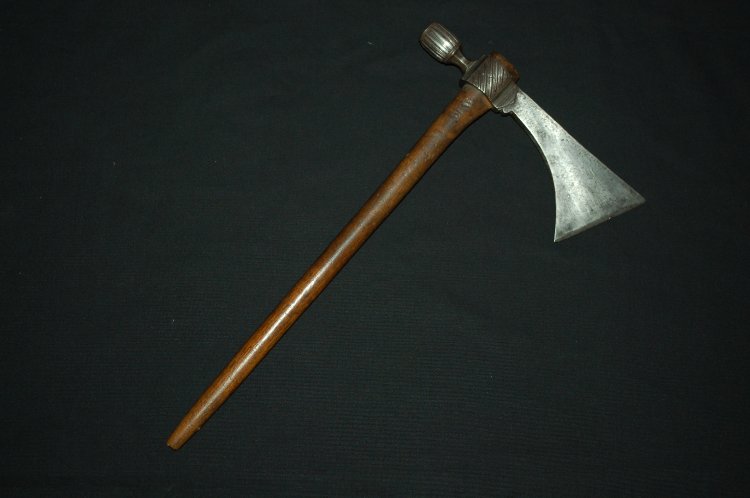The tomahawk peace pipe pictured above (top) was presented to Thomas Worthington by Tecumseh in 1807 when he visited Worthington at Adena, Tecumseh’s Chillicothe home. The tomahawk is made of forged metal and the wooden handle is decorated with engraved silver inlay. The Shawnees lived in a region that included Ohio before being relocated to the west in 1831. Tecumseh fought in several minor skirmishes and in the Battle of Fallen Timbers. He refused to sign the Treaty of Greenville in 1795 and was later killed in the Battle of the Thames in 1813 where he sided with the British in hopes of gaining lost Indian lands. The tomahawk pipe is on loan from the Ohio History Connection to the Eastern Shawnee Tribe of Oklahoma where it will be on display at the Indigo Sky Hotel and Casino in Wyandotte, Oklahoma for one year. The axe pictured at the bottom was given to Tecumseh by the British for his alliance during the war of 1812. You can magnify the view to read the inscription.
The tomahawk on the left is from a Powhatan village in Pennsylvania. The tomahawk on the right was traded to the Indians by the Hudson Bay Company and is sometimes referred to as a frontiersman’s axe.
The tomahawk, also referred to as a hawk, is a type of axe from North America, traditionally resembling a hatchet with a straight shaft. The name came into the English language during the 1600’s as an adaptation of the Powhatan word tamahaac, meaning “to cut off by tool.” They were a general purpose tool used by Indians and European colonialists alike as a hand-to-hand weapon that could also be thrown. The axe head was originally based on a Royal Navy boarding axe and used as a trade-item with the Indians to secure food and other provisions. The tomahawk began to be traded to Native Americans between 1750 and 1850. Tomahawks were made for trade by the American colonists and gunsmiths like John Small (1790-1820) and Squire Boone, the brother of famed Daniel Boone, about 1780.
The peace pipe tomahawk to the right was used by the French and traded to the Indians during the Fur Trade era. Those with a raised pipe bowl on a pedestal date to the mid 1700’s. The design of the tomahawk to the right is unique in that it has a dove-tailed bit and dates to 1850.
The tomahawk on the left is referred to as a Spontoon type that dates to about 1875 and occurs primarily in sites within the western plains region. The tomahawk on the right is a rarer spike form that dates to the 1830’s.
The modern tomahawk shaft is usually less than 2 feet in length, traditionally made of hickory, ash, or maple. The heads weigh anywhere from 9–20 ounces with a cutting edge usually not much longer than four inches from toe to heel. The poll can feature a small hammer, spike or simply be rounded off, and they usually do not have lugs. These sometimes had a pipe-bowl carved into the poll, and a hole drilled down the center of the shaft for smoking tobacco through the tomahawk. There was a clean-out plug at the head end of the pipe. There are also metal-headed versions of this unusual pipe. Pipe tomahawks are artifacts unique to North America: created by Europeans as trade objects but often exchanged as diplomatic gifts. They were symbols of the choice Europeans and Native Americans faced whenever they met: one end was the pipe of peace, the other an axe of war.

This is a French-made francisca type tomahawk the appears primarily in the French controlled Northeast Fur Trade areas (note pedestalled pipe bowl).
In colonial French territory, a very different tomahawk design, closer to the ancient European francisca, a throwing axe used as a weapon during Middle Ages by the Franks. In the late 18th century, the British Army issued tomahawks to their colonial regulars during the American Revolutionary War as a weapon and tool.